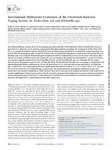International Multicenter Evaluation of the DiversiLab Bacterial Typing System for Escherichia coli and Klebsiella spp

Date
2013-12Author
Subject
Metadata
Show full item recordAbstract
<jats:title>ABSTRACT</jats:title> <jats:p> Successful multidrug-resistant clones are increasing in prevalence globally, which makes the ability to identify these clones urgent. However, adequate, easy-to-perform, and reproducible typing methods are lacking. We investigated whether DiversiLab (DL), an automated repetitive-sequence-based PCR bacterial typing system (bioMérieux), is suitable for comparing isolates analyzed at different geographic centers. A total of 39 <jats:named-content content-type="genus-species">Escherichia coli</jats:named-content> and 39 <jats:named-content content-type="genus-species">Klebsiella</jats:named-content> species isolates previously typed by the coordinating center were analyzed. Pulsed-field gel electrophoresis (PFGE) confirmed the presence of one cluster of 6 isolates, three clusters of 3 isolates, and three clusters of 2 isolates for each set of isolates. DL analysis was performed in 11 centers in six different countries using the same protocol. The DL profiles of 425 <jats:named-content content-type="genus-species">E. coli</jats:named-content> and 422 <jats:named-content content-type="genus-species">Klebsiella</jats:named-content> spp. were obtained. The DL system showed a lower discriminatory power for <jats:named-content content-type="genus-species">E. coli</jats:named-content> than did PFGE. The local DL data showed a low concordance, as indicated by the adjusted Rand and Wallace coefficients (0.132 to 0.740 and 0.070 to 1.0 [ <jats:named-content content-type="genus-species">E. coli</jats:named-content> ] and 0.091 to 0.864 and 0.056 to 1.0 [ <jats:named-content content-type="genus-species">Klebsiella</jats:named-content> spp.], respectively). The central analysis showed a significantly improved concordance (0.473 to 1.0 and 0.290 to 1.0 [ <jats:named-content content-type="genus-species">E. coli</jats:named-content> ] and 0.513 to 0.965 and 0.425 to 1.0 [ <jats:named-content content-type="genus-species">Klebsiella</jats:named-content> spp.], respectively). The misclassifications of profiles for individual isolates were mainly due to inconsistent amplification, which was most likely due to variations in the quality and amounts of the isolated DNA used for amplification. Despite local variations, the DL system has the potential to indicate the occurrence of clonal outbreaks in an international setting, provided there is strict adherence to standardized, reproducible DNA isolation methods and analysis protocols, all supported by a central database for profile comparisons. </jats:p>
Collections
Publisher
Place of Publication
Journal
Volume
Issue
Pagination
Author URL
Recommended, similar items
The following license files are associated with this item:

